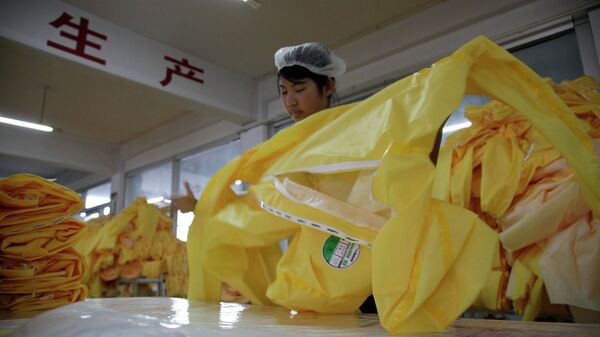MOSCOW, November 5 (RIA Novosti) — The Associated Press reports that 6,000 protective Ebola suits are being made every day in a Chinese factory, which has plans to double that number by January.
"We are very proud that the protective suits we manufacture can be used by those who are fighting against Ebola," the AP reports factory general manager Wang Ximin as saying.
Wang explained that demand for the yellow suits is 30 to 40 percent higher than last year, which are exported to West Africa for use by medics, as well as to the US and Europe. The factory in the eastern Shandong province has a contract with the US company Lakeland Industries to produce the clothing, which is completely sealed with both thread and glue to create an impermeable barrier between the wearer and the patient.
Last month, USAToday reported that the WHO estimates a monthly need for 300,000 of the hazardous materials suits, also known as hazmat, with a possible 3 million suits to be used in the following nine months. The channel also said that another supplier of protective gear, DuPont, has more than tripled its production of products for the treatment of Ebola. The company was quoted as saying, "DuPont is deeply concerned for those impacted by the Ebola outbreak and we have been working since its onset to assist in the response effort."
The Ebola outbreak has seen stock prices of companies like Lakeland spike with news of new infections. In October, CBS News reported that Lakeland, along with Alpha Pro Tech and Versar, two other manufacturers of the suits, experienced stock market spikes of 10, 14 and 65 percent respectively the day after two health workers in Texas were announced as having been infected with Ebola.
However, the suits have to be used correctly in order to be effective. After the diagnosis of the two nurses infected with Ebola in Dallas, fears grew about transmission despite the use of protective gear, which is hard to take off. "It is very difficult to get out of them without accidentally contaminating yourself, unless you do it perfectly," Mark Jarrett, chief quality officer at the North Shore Long Island Jewish Health System in New York told AFP.
The director of the US Centers for Disease Control and Prevention said that training and education in using protective equipment needed to be improved, telling the Wall Street Journal: “We have to rethink how we address infection control.” The European Centre for Disease Prevention and Control last week released detailed guidelines along with a video tutorial on how to use protective equipment like the hazmat suit effectively.

